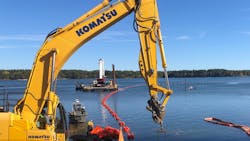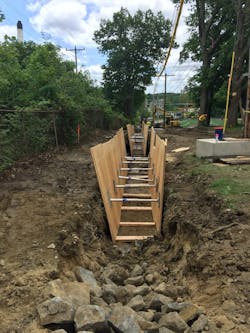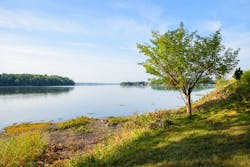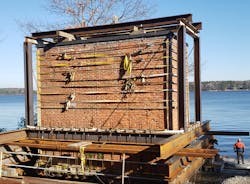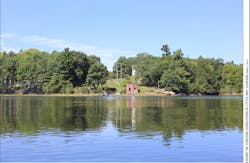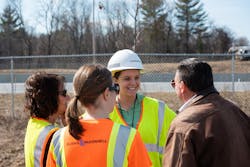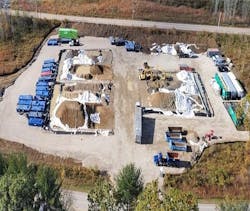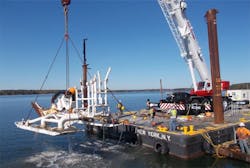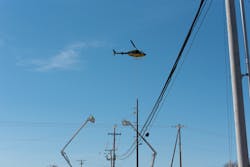Protecting the New England Sea Coast During Eversource Transmission Upgrades
The New Hampshire Seacoast region grew substantially over the last decade, straining the existing transmission system and leading to the need for additional transmission capacity. Critical customers in this area include precision manufacturers, pharmaceutical companies, investment firms, universities and a large residential population.
To prevent outages and support the increased demand, the Independent System Operator of New England (ISO-NE) selected a suite of projects, including the complex Seacoast Reliability project, to modernize the system in the region. Overseen by Eversource’s engineers and project managers, the Seacoast’s 13-mile (21-km) long, 115-kV transmission line was energized on May 29, 2020, after thorough planning and execution. The final route traveled along a rail line, across a college campus, through residential neighborhoods and historic sites, and beneath an environmentally sensitive tidal bay.
Workable Solutions
When Eversource energized the Seacoast Reliability project in 2020, it was the culmination of more than seven years of effort. From the beginning, the utility was committed to involving the public, regulators and officials to identify solutions that would work for the community, meet regulatory requirements, and provide safe and reliable energy. The project was subject to review by the New Hampshire Site Evaluation Committee along with other regulators and needed to display clear benefits to the region while mitigating adverse impacts.
More than 550 meetings were held with external stakeholders where numerous project improvements were identified and incorporated based on their feedback, including more than 20 revisions to engineering design drawings. While the project took longer than originally anticipated, the final designs mitigated impacts to the natural beauty of densely forested areas and seacoast waterways, among other critical natural and cultural resources. They also helped to maintain the historic character of nationally registered historic landmarks and other historic areas.
Eversource assembled a team of industry experts to engineer, site and permit this complicated project. POWER Engineers Inc. was engaged to conduct a routing and siting analysis and perform most of the detailed design work. The routing analysis helped the utility to determine the most appropriate path for the new line. That review identified three potential paths to connect the two required substations, with the primary focus on using existing utility rights-of-way to reduce adverse impacts.
The Best Alignment
- The project team evaluated the three potential primary routes as well as multiple sub-routes within those primary paths to identify the best alignment for the region.
- The criteria under review included how the routes affected abutting properties, the environment and cost, and the electrical and safety requirements of the project.
- The detailed review confirmed the choice of a preferred route, which enabled the utility to move forward with design, permitting and construction.
Based on this review, the proposed 115-kV design was a hybrid line that included two underground sections and a submarine cable crossing connected, by means of a vault, to a third section of underground. The remainder of the 13 miles was primarily overhead monopole construction with distribution underbuild.
Eversource and POWER Engineers worked through the detailed design with municipal officials, permitting agencies and abutting property owners to minimize effects on the community. The overhead design reduced the number of structures in parts of the corridor and lowered the structural height by using a horizontal configuration with spacer cable for the underbuilt distribution. This design met the public’s desire to reduce visibility of the structures. Where the design itself could not be adjusted, plantings helped to screen the new structures and mitigate impacts.
As a result of these efforts, the New Hampshire Site Evaluation Committee unanimously approved the route in December 2018. The commitment to stakeholder and community outreach and collaboration shown during the design and permitting phases continued through to construction to complete the project successfully.
Going Across Campus
A local university was in the line’s path, just south of Eversource’s Madbury substation. The proposed route crossed the main access road to the campus, passing by an old train station and a newly constructed football stadium. Eversource agreed to place 2100 ft. (640 m) of the line underground to reduce visual impacts and avoid any future design conflicts for the university.
Working on a college campus presented unique challenges. The campus had 150 years of buried and aboveground utilities and facilities. A high-pressure methane gas transmission line for cogeneration, which needed to remain in service, also was located on campus grounds. Furthermore, the university had its own projects and goals. The school only performed major construction when its student population was not on campus, during the eight to 10 summer weeks and four weeks of winter break. The school required Eversource to be held to the same schedule.
The utility worked closely with the university’s staff to design a route for the line that would avoid disturbing the campus as much as possible. This included designing around a proposed new athletic field. Led by POWER Engineers, the project’s underground team initially planned to build the line before the university finished its new field, giving the crew ample room to install the duct bank and cable. However, because of the time needed for project planning and permitting, the university ended up completing the new athletic field before construction began on the transmission line.
The team adjusted and rerouted the project out of the field and onto the street, including a crossing of the university’s most trafficked areas. Working in this very narrow path was like threading a needle at times. Close coordination among the field crews, engineering and university staff was critical to making the project a success.
Under the tight summer timeline, construction began the week following the university’s commencement. The project team completed the duct bank, riser poles and foundations, and proof tested the conduit. Despite the team’s best efforts, the cable was not fully installed by the end of the
summer break.
Therefore, it was decided to complete the cable pulls and terminations during the winter break. To account for cold weather, Eversource’s contractor had to take several extra steps. This included heating the cable so it would be soft enough for installation. Under the winter conditions, the project team finished construction just before the school’s second semester started in January.
Marine Life Protection
The transmission line also needed to cross Little Bay, a tidal estuary on the state’s southern tip. The bay lies between Great Bay and the Piscataqua River, which empties into the Gulf of Maine and is a unique ecosystem and scenic resource to the state. Overhead options were quickly ruled out because of the distance of the crossing, the heights of the structures that would be required and the location of a nearby airport. Directional drilling was evaluated extensively but ultimately eliminated because of the length, location and residential impacts.
A thorough review of design alternatives resulted in burying an armored submarine cable to cross 1.1 mile (1.7 km) using a hydroplow, a machine designed to lay and bury armored cable.
While hydroplowing is a common technology and industry practice for cable installations in water crossings and estuaries, hydroplow installation had never been used in New Hampshire. Regulators and local officials were cautious about signing off on the plan in a sensitive natural resource. Community members were concerned installation of the cable would raise a large plume of silt the current could carry downstream, affecting eel grass beds, wildlife and oyster farms near the project area.
To mitigate these concerns, Eversource and its teams conducted extensive field tests of the sediments and materials within them. They performed detailed modeling and studies to show how the hydroplow operation would affect the turbidity of the water. The teams developed and explained their plan for timing the tide cycle to minimize how the sediments would travel during the operation. Environmental monitoring stations and controls helped to ensure the water quality remained within permitted limits. The extra modeling and studies paid off. In the end, the actual cable burying operation generally resulted in much lower silt levels than the project team modeled.
Before laying the cable, Eversource needed to clean up work done a century ago. In the early 1900s, utility crews installed a 4-kV cable at the same crossing as part of one of the first long-distance electric lines in the state. Over the decades, the cables were upgraded to 34 kV to meet added demand. These cables had been damaged, repaired and eventually abandoned. This left large cable pieces scattered across the bay floor. Eversource hired the new cable installation contractor to identify the old pieces of cable, cut them up and bring them to the surface for disposal. This eliminated the risk of the old cables affecting the new cable installation.
The National Historic Preservation Act Section 106 consultation process with the New Hampshire Division of Historical Resources revealed the 1900-era cable installation included the original brick cable termination house on the western shore. Constructed in 1902, it was considered a historic building. However, it was in the path of the new construction.
Eversource worked with historic restoration experts to stabilize and relocate the historic building away from the path of the new line. After the new cable was installed, workers moved the house to a new location near the original site and fully restored it for future generations to appreciate.
Historic Farmland
Another community treasure is an old family farm in the Newington Historic District listed on the National Register of Historic Places that has a 1950s-era distribution line and right-of-way crossing the property. To restore the historic character of the farm, Eversource relocated the existing distribution line from the right-of-way in the farm field to the roadside. A half mile (0.8 km) of the new transmission line also was constructed underground within the right-of-way crossing the field.
The new underground transmission line was designed with additional cover to protect it and farm equipment from damage. The civil contractor worked closely with certified soil scientists to segregate each layer of soil before installing the duct bank and then placed the soil back in the same layers, closely monitoring compaction. This enabled the family to continue farming the land over the line without losing soil nutrients.
Eversource accommodated an underground design in several other locations within the town of Newington. The town’s Pease Airport became an added challenge to the underground construction, not because of the large cargo planes flying overhead but because of the groundwater. After years of firefighting training at the airport and other activities in the area, the groundwater had become contaminated and flowed into the area of the duct bank. Crews collected more than 22,000 tons of soil and disposed of contaminated dirt. No contaminated soil was returned to the ground. They also collected and treated around 385,000 gal (1750 cu m) of water.
Railway Signals
Three miles (4.8 km) of the 10 miles (16 km) of overhead transmission line run along a Pan Am Railways corridor in the same location as an existing 34.5-kV circuit. Eversource sought to design the new transmission line to avoid any conflicts with railway signals.
The team conducted an alternating-current interference study to analyze ground faults on the existing lines and future 115-kV line and created a virtual world to match the real-world conditions. The study helped to determine a design that would mitigate any potential conflicts with signals on the railroad system and high-touch voltage concerns during faulted scenarios.
Because of the extensive amount of rock in the area, the conductivity of the soil was very poor, reducing the effectiveness of the grounding system. The mitigation design required extensive additional grounding at the transmission structures and counterpoise grounding running between structures in any areas that did not require road crossings or wetland crossings.
The railroad itself also required counterpoise grounding for faulted conditions. However, this grounding could not be connected directly to the railroad tracks during normal conditions because the railroad’s signaling circuits include the track itself and would not work properly if grounded. Rail fault protectors were installed between the track and grounding system, which are off under normal operating conditions. Under abnormal conditions, such as a fault or lightning surge, the rail fault protector switch nearly instantaneously turns on and begins conducting, which enables the connection between the track and grounding system.
Key To Success
The Seacoast Reliability project involved all aspects of transmission line design and construction, including underground, overhead, submarine, distribution and substation. With the permitting, public approval process and construction lasting for more than seven years, frequent communication and collaboration among project teams proved essential to keep everyone on track.
The key to project success was communicating both what the plans were and why. Close coordination early on with permitting professionals, design and studies engineers, project managers and construction contractors helped to address challenges quickly and avoided affecting other parts of the project. The project involved numerous stakeholder meetings, briefs and site visits as part of the massive, coordinated effort. As a result, Eversource energized a line that met the needs of the surrounding communities while delivering safe, reliable service to the region’s businesses and residents.
Joseph Sperry, P.E., is a senior engineer for Eversource. He is an experienced civil and transmission line engineer, including substation, overhead, underground and distribution design. He has a BSCE degree from the University of New Hampshire and a MSCE degree from Norwich University. He has extensive knowledge in the design, permitting, siting and maintenance of overhead and underground transmission lines and distribution facilities from 12 kV through 345 kV. He has been involved in the development of design, construction and structure detail standards for overhead transmission lines and substation structures.
Todd Goyette, P.E., is a senior project engineer with POWER Engineers Inc. He specializes in underground distribution and transmission line engineering. He has extensive experience in the design and operation of high-voltage and extra-high-voltage underground distribution and transmission cables and is knowledgeable in all aspects of design, permitting and licensing, installation, operation and maintenance of underground cable systems. He has experience with self-contained fluid-filled, high-pressure fluid-filled, high-pressure gas-filled and extruded dielectric cable systems. He also is skilled in field construction supervision during emergency events.
About the Author
Joseph Sperry
Joseph Sperry, P.E., ([email protected]) is a senior engineer for Eversource. He is an experienced civil and transmission line engineer, including substation, overhead, underground and distribution design. He has a BSCE degree from the University of New Hampshire and a MSCE degree from Norwich University. He has extensive knowledge in the design, permitting, siting and maintenance of overhead and underground transmission lines and distribution facilities from 12 kV through 345 kV. He has been involved in the development of design, construction and structure detail standards for overhead transmission lines and substation structures.
Todd Goyette
Todd Goyette, P.E., ([email protected]) is a senior project engineer with POWER Engineers Inc. He specializes in underground distribution and transmission line engineering. He has extensive experience in the design and operation of high-voltage and extra-high-voltage underground distribution and transmission cables and is knowledgeable in all aspects of design, permitting and licensing, installation, operation and maintenance of underground cable systems. He has experience with self-contained fluid-filled, high-pressure fluid-filled, high-pressure gas-filled and extruded dielectric cable systems. He also is skilled in field construction supervision during emergency events.
